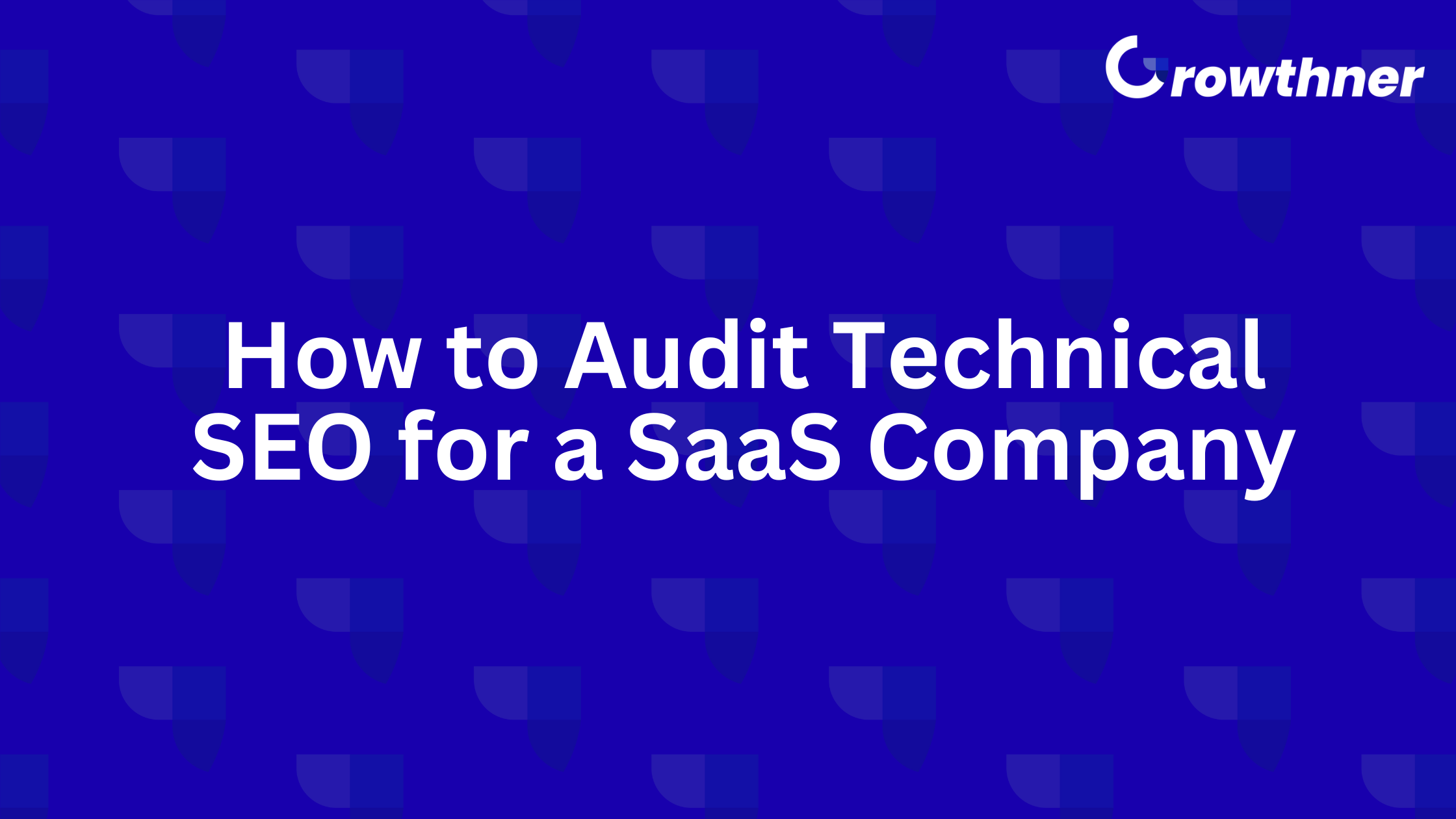07 Nov

Published by: Amit Kakkar
Published on: November 7, 2025
Last updated on: November 7, 2025
Last Updated on November 7, 2025 by admin
TL;DR
Technical SEO audits reveal hidden issues that prevent your SaaS website from ranking. This guide covers everything: crawlability checks, site speed fixes, mobile optimization, and indexing problems. You’ll learn an 8-step audit process with actionable tools like Screaming Frog and Google Search Console. Most SaaS sites fail Core Web Vitals tests, but fixing them increases user engagement by 24%. Follow this checklist to outrank competitors and drive more Product Qualified Leads.
Your content is exceptional. Your backlinks are solid. But your SaaS website still isn’t ranking.
Here’s the problem: 53% of mobile users abandon sites that take longer than 3 seconds to load.
And if search engines can’t crawl your pages properly, your content never reaches Google’s index.
Technical SEO issues silently destroy your visibility while competitors climb past you.
This guide shows you exactly how to audit technical SEO for a SaaS company. You’ll discover the 8 critical steps that reveal hidden problems. You’ll get actionable fixes that boost rankings and conversions. And you’ll learn which tools make audits faster and more effective.
By the end, you’ll have a complete roadmap to technical SEO excellence. Let’s get started.
What Makes Technical SEO Different for SaaS
SaaS agencies face unique technical challenges that B2C sites never encounter.
Your product documentation creates hundreds of pages. Multiple pricing tiers risk duplicate content. And your app integration often slows page speed dramatically. These issues compound quickly.
The competition is brutal too. The keyword difficulty for “software as a service” hits 83 out of 100. Most SaaS buyers research extensively before purchasing. They expect fast, secure websites with perfect mobile experiences.
Technical SEO determines whether search engines can access your content. It impacts crawlability, indexing, and user experience simultaneously. Only 33% of websites pass Google’s Core Web Vitals assessment. Master technical optimization and you gain an immediate advantage.
The 8-Step Technical SEO Audit Process
Here are top eight step of technical SEO audit process you must follow:
Step 1: Crawl Your Entire Website
Start with a comprehensive site crawl to identify technical issues.
Use tools like Screaming Frog, Sitebulb, or SEMrush to scan your entire site. Set the crawl to follow the same rules as Googlebot. This reveals broken links, redirect chains, and missing metadata.
Focus on these critical elements during your crawl:
- Pages with 404 errors or broken links
- Redirect loops and chains longer than 3 hops
- Missing or duplicate title tags and meta descriptions
- Pages blocked by robots.txt accidentally
- Orphan pages with no internal links pointing to them
Screaming Frog’s free version crawls up to 500 URLs. For larger SaaS sites, invest in the paid version at $190 annually. Export your crawl data to spreadsheets for easier analysis.
You can hire a technical seo agency too to make your work easier.
Step 2: Check Crawlability and Indexability
Ensure search engines can discover and index your most important pages.
Open Google Search Console and navigate to the Coverage report. Look for pages marked as “Excluded” or “Error”. These pages won’t appear in search results despite your best content efforts.
Review your robots.txt file by visiting yoursite.com/robots.txt. Confirm it doesn’t block critical sections like your blog or product pages. A single misconfigured line can hide your entire site from Google.
Verify your XML sitemap includes all important pages. Submit it through Google Search Console under Indexing > Sitemaps. Your sitemap should update automatically when you publish new content.
Use the site: operator to check indexing. Type “site:yoursite.com” into Google. If the result count seems low, you have indexation problems.
Step 3: Analyze Site Architecture
Your site structure determines how easily users and search engines navigate your content.
Follow a flat hierarchy where every page sits within 3 clicks of your homepage. Deeper pages receive less crawl priority and rank worse. Reorganize your structure if important pages are buried.
Implement breadcrumb navigation to show users their location. This improves user experience and helps Google understand your site structure. Breadcrumbs appear like: Home > Products > Analytics > Features.
Use subfolders over subdomains for most SaaS sites. Subfolders consolidate your domain authority. Subdomains split it across multiple properties. Only use subdomains for completely separate properties like a knowledge base.
Step 4: Optimize Page Speed and Core Web Vitals
Page speed directly impacts both rankings and conversions.
Test your site with Google PageSpeed Insights. You’ll get scores for mobile and desktop plus specific recommendations. Aim for these 2025 benchmarks:
| Metric | Good | Poor | What It Measures |
| Largest Contentful Paint (LCP) | ≤ 2.5 seconds | > 4.0 seconds | Loading performance |
| Interaction to Next Paint (INP) | ≤ 200 milliseconds | > 500 milliseconds | Responsiveness |
| Cumulative Layout Shift (CLS) | ≤ 0.1 | > 0.25 | Visual stability |
Websites meeting Core Web Vitals standards see a 24% increase in user engagement. A one-second delay in mobile load time drops conversions by 20%.
Quick wins to improve page speed:
- Compress images using WebP format
- Enable browser caching
- Minimize CSS and JavaScript files
- Use a Content Delivery Network (CDN)
- Remove unused third-party scripts
- Implement lazy loading for images below the fold
Step 5: Ensure Mobile-Friendliness
Mobile devices generate 62.54% of global organic search traffic.
Google uses mobile-first indexing, meaning it ranks your site based on the mobile version. If your mobile experience is poor, your rankings suffer across all devices.
Test mobile-friendliness using SEMrush’s Site Audit Tool. Select the “Mobile SEO” category under Issues. Common problems include:
- Text too small to read without zooming
- Content wider than the screen
- Touch elements too close together
- Intrusive interstitials blocking content
Fix mobile issues by implementing responsive design. Your site should automatically adjust to any screen size. Optimize pop-ups to be smaller and less intrusive on mobile. Consider AMP (Accelerated Mobile Pages) for blog content.
Step 6: Audit HTTPS and Security
Security is both a ranking factor and a trust signal.
Every page on your site should use HTTPS protocol. Check for mixed content warnings where HTTPS pages load HTTP resources. These create security vulnerabilities and hurt rankings.
Common HTTPS issues and fixes:
- Expired SSL certificates: Renew through your hosting provider or use Let’s Encrypt for free
- Mixed content: Update all internal links to use HTTPS
- HTTP versions still accessible: Implement 301 redirects from HTTP to HTTPS
- Canonical tags pointing to HTTP: Update all canonical tags to HTTPS versions
88% of websites now use HTTPS. If you’re still using HTTP, you’re falling behind competitors and losing user trust.
Step 7: Fix Duplicate Content
Duplicate content confuses search engines about which page to rank.
SaaS companies often create duplicate issues through:
- Multiple pricing pages for different company sizes
- Product variations with nearly identical descriptions
- www and non-www versions both accessible
- HTTP and HTTPS versions both indexable
- Paginated content without proper handling
Use canonical tags to specify the preferred version of duplicate pages. Add this code to the head section: <link rel=”canonical” href=”https://yoursite.com/preferred-page” />.
For pages that shouldn’t rank at all, add a noindex meta tag. This keeps them on your site for users but removes them from search results.
Tools like Copyscape detect duplicate content across the web. Siteliner finds internal duplicates on your own site. Also, you can hire a professional SaaS content marketing agency to fix this issue.
Step 8: Implement Structured Data
Schema markup helps search engines understand your content better.
Structured data enables rich results like star ratings and FAQ snippets in search. Websites using structured data see up to 40% higher click-through rates.
Essential schema types for SaaS companies:
- Organization schema for your company information
- Product schema for pricing pages
- FAQ schema for common questions
- Article schema for blog posts
- Review schema for customer testimonials
- SoftwareApplication schema for your product
Implement schema using JSON-LD format. Test your markup with Google’s Rich Results Test. Unfortunately, 31.2% of websites don’t use structured data at all.
Critical Tools for Technical SEO Audits
Invest in the SaaS tools mentioned below to bring the best out of your technical SEO efforts.
Google Search Console
The essential free tool for monitoring crawl errors and indexing issues. Submit your sitemap here and track performance over time. The Coverage report shows exactly which pages Google can’t access.
Screaming Frog SEO Spider
The gold standard for site crawls. It identifies broken links, duplicate content, and missing metadata. The free version handles 500 URLs. Upgrade to the paid version for unlimited crawling at $190 per year.
Google PageSpeed Insights
Analyzes Core Web Vitals and provides specific optimization recommendations. Tests both mobile and desktop performance. Integrated with Google Lighthouse for deeper technical analysis.
SEMrush Site Audit
Comprehensive auditing tool that categorizes issues by priority. Excellent for tracking mobile-specific problems. Monitors your site continuously and alerts you to new issues.
Sitebulb
Similar to Screaming Frog but with better data visualization. Creates easy-to-understand graphs showing your site’s health. Particularly useful for presenting audit findings to non-technical stakeholders.
Common Technical SEO Mistakes to Avoid
Here are some common technical seo mistakes most SaaS companies do and tips to avoid them :
- Blocking important pages in robots.txt is the most dangerous error. Always test robots.txt changes using Google Search Console’s robots.txt Tester. One wrong line can deindex your entire site.
- Ignoring redirect chains wastes the crawl budget. Google may stop following redirects after 3-5 hops. Replace chains with direct 301 redirects to the final destination.
- Forgetting to update canonical tags after site migrations causes indexing chaos. Audit all canonical tags quarterly to ensure they point to the correct URLs.
- Neglecting log file analysis means you miss how Googlebot actually crawls your site. Server logs reveal which pages Google prioritizes. Adjust your internal linking based on these insights.
Final Thoughts
Technical SEO separates SaaS companies that dominate search from those that struggle.
You now have a complete 8-step audit process. You understand which tools make audits faster and more accurate. And you know the critical mistakes that destroy rankings.
Most importantly, you have a roadmap to fix issues systematically. Start with crawlability and indexing problems. Then optimize speed and mobile performance. Finally, implement structured data for rich results.
Your competitors aren’t waiting. Neither should you.
Technical SEO requires constant monitoring and expertise. At Growthner, we handle every aspect of your technical foundation.
Our comprehensive technical SEO audits identify issues killing your rankings. We fix crawlability problems, optimize Core Web Vitals, and implement structured data.
We also integrate Reddit marketing strategies that boost your overall domain authority.
Our geo-targeting and LLM SEO services ensure you appear in AI-generated results. We build high-quality backlinks that strengthen your technical foundation. And our B2B SaaS SEO specialists understand your unique challenges.
Want to see how technical SEO transforms your organic growth?
Book a strategy call with Growthner today.
FAQs
How often should I conduct a technical SEO audit?
Conduct comprehensive audits every 6 months. After major site updates like redesigns or migrations, run immediate audits. Monitor critical metrics weekly using Google Search Console to catch issues early.
What’s the biggest technical SEO mistake SaaS companies make?
Ignoring page speed optimization is the most common error. SaaS sites often load slowly due to complex app integrations. This fails Core Web Vitals tests and increases bounce rates dramatically.
Can I do technical SEO without a developer?
Many technical SEO tasks require development resources. However, you can identify issues using audit tools and prioritize fixes. Partner with developers or hire specialists like Growthner for implementation.
How long does a technical SEO audit take?
A thorough audit takes 15-20 hours for most SaaS sites. Larger sites with thousands of pages may require 30-40 hours. Use automated tools to reduce audit time significantly.
Do technical SEO fixes guarantee higher rankings?
Technical SEO is foundational but not sufficient alone. You also need quality content and strong backlinks. However, technical issues prevent even great content from ranking. Fix technical problems first to maximize other SEO efforts.







Amit Kakkar